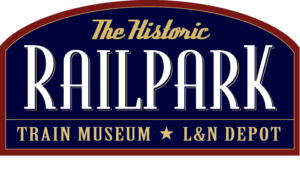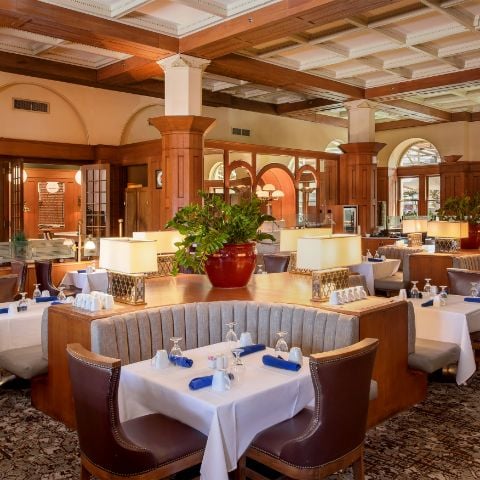Inaugurated in 1875, the legendary 1 1/4-mile race for 3-year-olds is the longest continually held major sporting event in North America and the first leg of horse racing’s Triple Crown series. The Derby is the most attended horse race in the nation. The 150th Kentucky Derby will take place on May 4, 2024.
In this week’s edition of “Off the Rails” we share with you an article posted in the Farewell Edition – No. 578 May-June 1974 publication of the L&N Magazine. This was the last edition of the named publication. The next issue would be named Family Lines to debut in July-August 1974.
Tradition-clothed record-breaker That was … KENTUCKY DERBY NO. 100 By Charles B. Castner
Photos by Bill Tayse or from L&N public-relations files, unless otherwise credited.
On a sunny Monday in mid-May 1875, Aristides galloped to victory in the first running of a then-brand-new race, the Kentucky Derby. Just a month ago, 99 years later, Cannonade broke from the scrambled 23-horse field to win the 100th run of what has become sportsdom’s most exciting two minutes and the premier horse race in the world, that same but now celebrated Kentucky Derby! From whatever perspective we view the Derby the horses, their owners and trainers, the jockeys, Churchill Downs itself, or the men who’ve helped make the race what it is today the saga from 1875 to 1974 is a stirring one.
The intervening years have brought a host of changes to the race, and the temporary bleachers be side that 1875 racecourse are a far cry from the multimillion-dollar plant that is Churchill Downs to day. Of course, too, personalities, faces, fashions, and just about everything connected with the race have changed, lo! these 99 years since Aristides’ victory in 1875. Still, something elusive, yet very real, hasn’t changed. That spirit of the Derby call it Derby Fever if you will has spurred horsemen everywhere to enter only their top Thoroughbreds. It has inspired others to refine and polish a great event to ever-greater gloss. To millions over the years, that elusive spirit gas afforded thrills like few other sports events. That first Derby, run on Monday, May 17, 1875, and won by the ‘little red colt named Aristides,” launched 99 succeeding Derbies, each building on the ones before it.
To ensure sufficient stakes to all entries in “Derby One, “the then newly organized Louisville Jockey Club ran short of cash and couldn’t complete the planned grandstands on the Churchill Farm racecourse. So, make-shift bleachers went up, and some 2,000 persons occupied them to cheer on their favorites. Another 8,000 or so along the track or perched themselves on wagons and carriages.
Within sight of the Churchill property and the Derby site was L&N’s main line, running south from Louisville to Nashville. Probably some of those first Derby onlookers came by rail. For sure, by the late 1870’s and early 1880’s. L&N was regularly bringing race fans by the trainload to the big race, beginning a “by-rail-to-Derby” tradition. Within major lines radiating in all directions from Louisville, L&N transported both people and horses to and from the Derby for many, many years.
Among spectators at the 1875 Derby was a 14-year-ld Matt Winn, the son of a local grocer, who watched the race from the back of his father’s wagon, twenty-seven years later, Mr. Winn became general manager of the track, and under his personal direction, the Derby achieved its international preeminence. In the early 1880’s the Derby racecourse was officially named Churchill Downs, and in 1884, Isaac Murphy, the celebrated black jockey, won the first of his several Derby triumphs. In 1898, the Derby distance was reduced to its present mile and a quarter. In 1984, new stands crowned by the framed twin spires were begun, completed in time for throngs at the ’95 Derby to see Kentucky-bred Halma romp to glory. By then, too, the race was scheduled in early May, usually on the first Saturday.
In 1902, young Matt Winn came on the Derby Churchill Downs scene. He acquired badly needed cash to renew the lease on the Churchill property, to buy existing buildings, and to start construction of a new clubhouse. He faced challenges aplenty. In 1908, the year Stone Street won, only the last-minute substitution of parimutuel betting machines by Mr. Winn overcame a local political squabble about the legality of bookmaking.
Two major floods in 1913 and 1937; a Derby Day downpour of 1.19 inches in 1929, and two World Wars also threatened to halt the race, or at least dampen it! But Mr. Winn saw to it that the big race did go. In 1945, as World War 11 ended, the Derby was delayed until June 9, a month after V-E day. That year, as in previous wartime Derbies, most race fans rode to and from the Downs on trolley cars and L&N’s out-of-town race traffic was greatly curtailed.
New York sportswriter Bill Corum back in the 1920s gave the Derby its moniker, “Run For The Roses.” Flowers of one kind or another had been presented to winning jockey well before the turn of the century, but in 1904, a garland of American Beauty roses went to Mrs. Charles E. Durnell, whose colt Elwood, won that year’s Derby. Appropriately, Mr. Corum succeeded Matt Winn as president of the Downs when Mr. Winn retired in 1949.
Under direction of the late Wathen Knebelkamp, Downs president during the 1960s, extensive physical betterments costing more than $5 million were undertaken, including new stables, jockey quarters, press box, museum, and renovation of many other buildings. Also, reconstruction of the grandstands and addition of the elevated “Skye Terrace” were completed to handle record-size crowds packing the Downs each Derby Day. On the track’s board of directors in that era was A.B “Bull’ Kancock, now deceased, who eventually joined our railroad’s board. Mr. Kancock a noted horse breeder was owner of famed Claiborne Farms. His son Seth, 25, now runs the plant with great skill. Some of the nation’s finest Thoroughbreds call Claiborne home.
As previously noted, the “rail-to-races” story is nearly as old as the Derby itself. Some Louisvillians reportedly took the train to and from the 1875 race, and in the ’78, a 19-car special brought in Derby goers from Cincinnati. By the 1890s, the Derby attracted both area citizenry and wealthy businessmen, sportsmen, and the socially prominent from all parts of North America. Some even came abroad elegantly decorated private rail cars. By 1920, derbies drew upward of 50,000 a significant number coming by to rail to Louisville. Two years later when Morvich “won the roses,” some 450 extra cars (handled either with special or on regular trains) swamped the city’s stations and rail yards. At Union Station, L&N, Monon, and Pennsylvania parked over 250 extra sleepers and private cars. On Derby night, the train-people jam got so thick that crews were hard put to get all the specials made up and rolling homeward before dawn on Sunday morning!
Railroad traffic and operating officials of the L&N and the other lines sharing Union Station vowed such confusion should never again be tolerated. So they met and determined policies for handling future Derby traffic scheduling, parking arrangements, assignment of cleaning and maintenance forces, and provisions of heating, lighting, and caring for needs of occupants of ‘Pullman City” at Union Station and tracks just behind our general office building. So well were trains and special cars expeditied in and out of Louisville in 1923 and at subsequent Derbies that, with but few changes, those same plans guided every “Operation Derby” until 1969, last big year for the L&N rail specials, The Pullman Company thought so highly of our Derby operations that it adopted similar plans for other major events requiring major sleep car travel.
The “railway” is still one of the most delightful ways to come to Kentucky for the Derby. Amtrak’s Floridian (on the Chicago-Louisville-Florida run) continues the tradition. This year Nos. 52-53 handled several special parties to “Derby 100”!
From start to finish, 1875’s “Derby One” at the one mile and a half took a hair over two minutes and 37 seconds. ‘Way back there, a Louisville editor declared that successive Derbies deserved a whole week of the festivities. Since 1956, such a week of activities, The Kentucky Derby Festival, has been keeping Louisvillians and visitors in a constant swirl of excitement. This year’s festival was a gala 10-day birthday party honoring the Derby centennial.
Events during the ’74 Festival included pop concerts by the internationally known Louisville Orchestra, a coronation ball; balloon, bicycle and steamboat races; and the two-hour Pegasus Parade. The floats depicted outstanding Derbies of the past and major historical events which took place in the century spanning the Derby’s inaugural and centennial. And, as usual, the Order of Kentucky Colonels sponsored several exciting events.
The 100th running of the Derby, now part of history, broke all sorts of records. First, the Derby field scream, whoop, holler or grimace when Cannonade broke loose on the far turn to outpace the field were 163,628 persons, a record. Derby wagering surpassed $3 million, while betting for the day topped $7.8 million, both also records.
To Cannonade’s over, John Olin of St. Louis, went the biggest Derby purse ever, $274,000, and a handsome silver trophy, presented by Great Britain’s Princess Margaret, who with her husband, Lord Snowden were in the winner’s circle with Downs President Lynn Stone to meet Cannonade.
But what is it that on a late afternoon in May at a twin-spired race track in Louisville literally galvanizes thousands within the confines of the track and many millions to TV’s and radios over the nation and much more of the world? The “fever” is hard to define, but Kentucky’s own Irvin S. Cobb wrote in the long ago: “Until you go to Kentucky and see, with your own eyes, a Kentucky Derby, you ain’t never been nowhere and you ain’t never seen nothin’!”
Or, as a nameless preacher once exclaimed, after witnessing a particularly thrilling Derby: “Heaven is shore a Kentucky kinda place!”












